The main focus of every tire producer is to come up with customer needs. So both of these All Terrain tires are made to give you high-quality experience in both harsh-terrains and pavements.
The famous Goodyear DuraTrac which is now more than a decade old, still surprises to this very day with it’s best combination of on and off road performance.
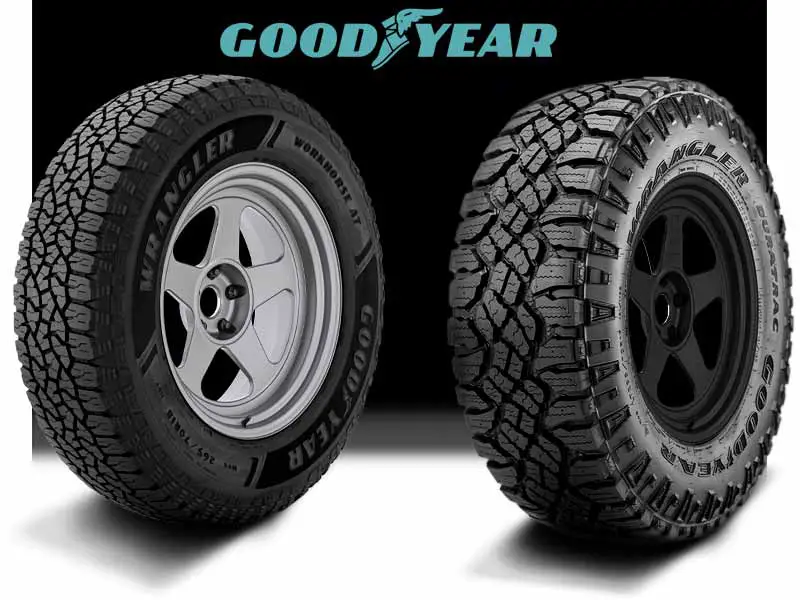
But by the looks of it, its seems the Goodyear Wrangler Workhorse is a more well-mannered on road tire?
So is that really so? Let’s find out.
Note: The Goodyear TrailRunner and WorkHorse are both same tires. There might be some differences in their sizes, but other than that, nothing is changed.
Table of Contents
Starting with the Design:
Goodyear Workhorse A/T
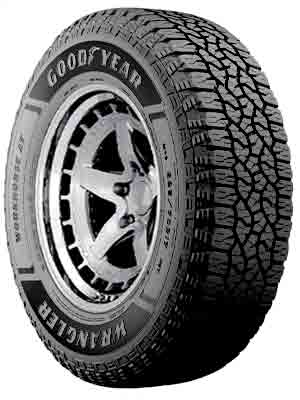
Goodyear DuraTrac
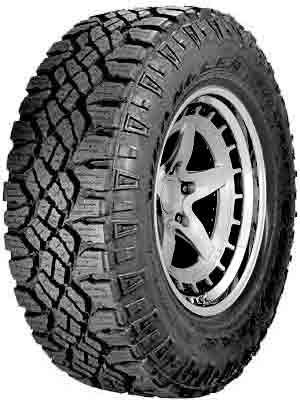
The Goodyear Workhorse AT has a central area of blocks which all resemble the horse shoe, hence the name.
But these blocks are stiff quite different from each other.
They are 3 unique blocks (highlighted with different colors, below).

The central “C” shaped blocks (colored with blue, and which are mirror images of each other) are surrounded by 2 (somewhat triangular shaped) green blocks on sides.
These green blocks then make wide lateral grooves by placing red blocks on their sides.
This pattern of these 6 blocks together repeat throughout the tire, making a combination of lateral and circumferential grooves.
If we look at DuraTrac, we again see a similar placement of complicated blocks, but again made easier for you, as they are colored.
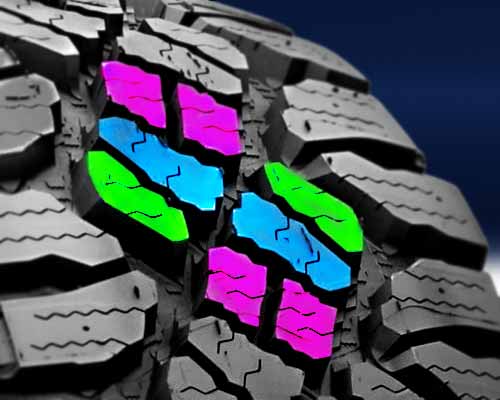
They are very blocky where the blue colored ones (again two making mirror images of each other) are surrounded with green block on one side and 2 pink blocks on the other.
All these blocks have teeths to them along with wave-like siping.
If we move towards the shoulder blocks.
On the Goodyear Workhorse AT, you see squared shaped blocks which hardly differ from each other, having stepped edges (ramps) on sides joining sidewall lugs.
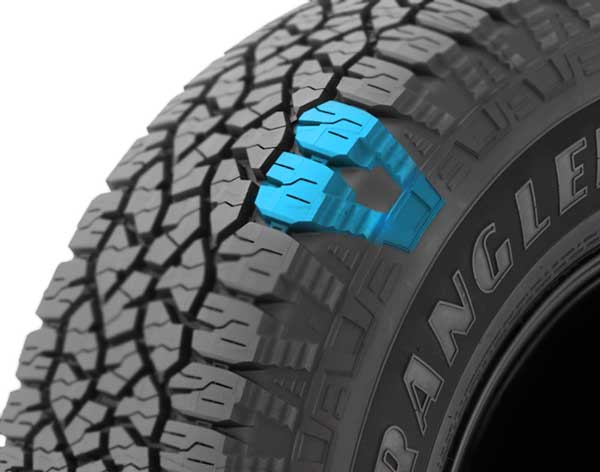
These blocks show rectilinear siping with deep notches facing the central area of the tire making more biting edges.
But overall the tire is still less agressive compared to Goodyear DuraTrac where the blocks have prominet scoops and stepped sides which join bulkier lugs on the sidewalls.
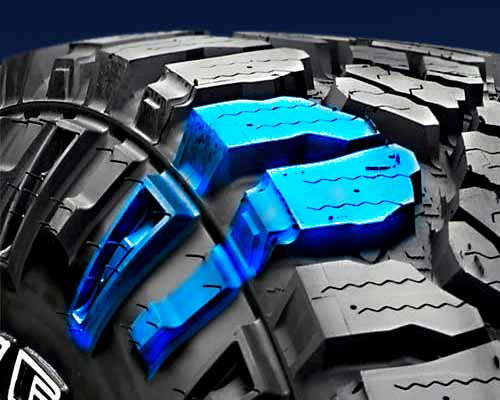
These lugs grab and pull in a much better way during flexing sidewalls.
How are these tires on Road?
Looking at the tread pattern of both, tires, it would seem that the DuraTrac with it’s wider grooves would lack behind with its smaller footprint, but things are very different.
Both tires show almost equal pavement performances with not much difference in braking distances and handling times.
But the Workhorse AT really disappointed on wet roads.
The tire’s lateral traction does not communicate too well with it’s circumferential one. So this means, the steering response of the tire is very confusing.
The tire gives limited feedback and you have to be very careful with them (not to over-brake), as they would slide very easily and it also takes a long time to recover form it, so you wait for understeer to finish, before you get your vehicle back in control.
On the other side, it was surprising to see how good DuraTrac was here, with better overall handling times and grip.
And although this tire really pulls of the steering wheel, it still more responsive in comparison.
And unlike the Workhorse AT, this tire would not overpower the front end side as much, so you feel more in control.
Note: It’s not recommended that you drive the Goodyear Workhorse (in wet conditions) with traction controls off.
So is DuraTrac overall better on roads?
Well, not really, if comfort is something on the top of your list, as these tires are very loud and they tend to get louder with wear.
Also expect these tires to consume almost 15% more of your fuel as well (compared to normal on road tires).
Can they handle Mud?
Despite DuraTrac’s being marketed as All Terrain, some people still consider them mud terrain tires, because of their wide spacing between the shoulder blocks.
These wide spacing combined with wilder circumferential rings of the tire make a clear path for mud to pass through.
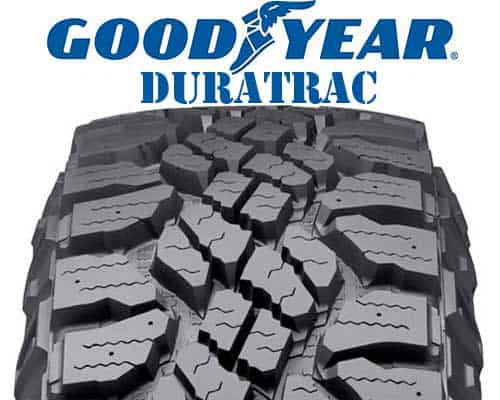
And the mud in contact with the central blocks gets crushed through, as these blocks squeeze and release munching on the surface.
The lodged mud is further broken down by it’s Tractive Groove Technology, which features mini tread blocks as shown below.
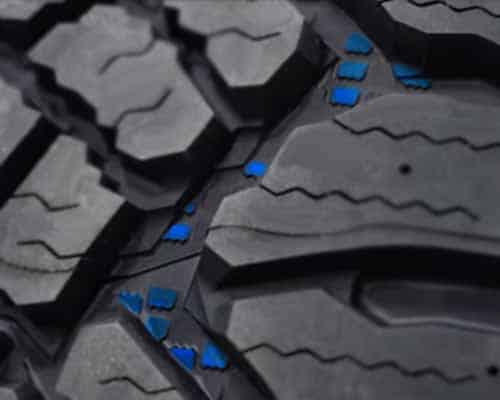
These tiny blocks further aid in breaking down the mud particles, so they can pass through the tire easily.
Other than this, as the tire makes bulkier shoulder blocks with bigger scoops in them, and bulkier sidewall lugs, the tire is better able to dig it’s way out, even when aired down deep in mud.
On the other side, the Wrangler Workhorse AT would simply get packed in saturated deep muddy terrains.
The tire does not offer wider grooves and although it makes somewhat serrated shoulders, they are no match to DuraTrac’s aggressive design.
And instead of mini tread blocks this tire features ridges between the shoulder blocks (highlighted with green).
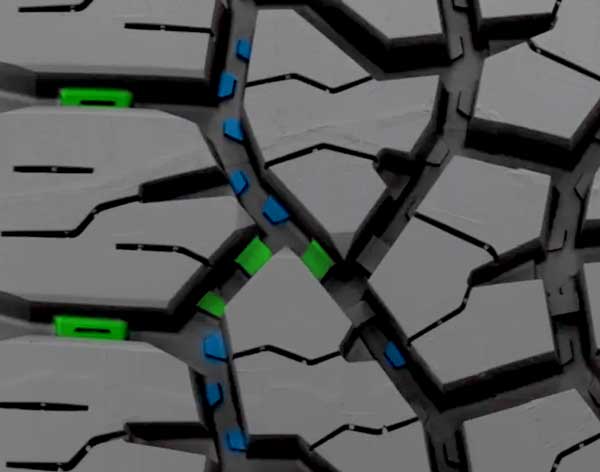
These ridges also interconnect with the central blocks creating a web which traps the mud very easily.
And since mud to mud contact loses traction, the tire gets stuck very easily, in comparison.
On Snow:
Both these tires are are “M+S” and “3 Peak Mountain Snowflake (3MPSF)” rated and they truly deserve it.
But is there any difference between their performance values?
Yes, there is.
The Goodyear Workhorse performs great in less deeper snow, (as in snow on roads). It shows better braking distances and acceleration values here.
The tire’s deeper slits (in sipes) gives the snowy surface micro level bite which maintains friction to a good level.
But things get tricky with deeper snow, especially if you are on a slope. It’s very hard to keep momentum with them.
And that’s where Goodyear DuraTrac comes in.
The tire features 3D wave like siping (instead of rectilinear in Workhorse) and deeper/wider grooves which accumulate in much more volume of snow,
And this helps because snow sticks better on snow (as snowflakes have a unique interlocking design and they root in to each other).
The accumulated snow is further broken down with the mini tread blocks so, they don’t get packed in there as well.
Other than this, the DuraTrac has one more advantage up it’s sleeves here.
It features a softer rubber, which does does not get too stiffen up with colder temperatures, and the tire is able to maintain grip in a better way.
FYI: AT tires with 3pmsf rating still get stiffen up under 20 degree F. That’s because their rubber is not made too soft like a dedicated winter tire.
And even if things get too cold, it features stable shoulder blocks. You can install 16 on these studs in them, but note that this feature only comes on LT sizes of this tire.
On Rocks:
Having a softer rubber of the two, the Goodyear DuraTrac simply sticks better on rocks.
But that’s just one factor, the tire has many, which makes it a better pick here.
The serrated shoulder blocks with wider lateral spacing, and zig zag circumferential grooves joining those channels, the tire produces more lateral traction in comparison.
Lateral traction is highly needed on rocks as it prevents the tire to skid sideways. On rocky terrains, with more lateral traction, the tire would not fall off course (which also results in overturning in some cases, damaging your vehicle, severely).
Other than this, the central rectangular blocks with sharp off set edges everywhere and reinforced foundations underneath those blocks, ensure the tire maintains grip in all directions.
On the other side, the Goodyear Workhorse, although can’t outperform the DuraTrac, still performs satisfactorily.
It features multiple biting edges on all of it’s sharp central blocks, which aid the tire a lot in hugging the surface of the rocks.
It’s deep siping also helps here, as it goes all the way deep down to the base and this allows the blocks to either further get divided or contract on themselves, so they munch on rocks.
Overall, both tires use cut resistant rubber that protects them form sharp rocks, especially when on high speeds on gravel.
And although both tires are missing with stone ejectors, the Workhorse AT is more prone to stones/dirt getting lodged in the tread (which either can damage the tread or make ride jittery).
Side Note: It’s very weird to see no stone ejectors in such wider grooves of Goodyear DuraTrac.
Furthermore, both tires have similar inner construction having 2 ply polyester sidewalls, so they are both prone to getting damaged there, but still out of the two, the bulkier sidewall lugs of DuraTrac brings in more protection here.
So the Verdict?
Well, if you want an aggressive looking tire, which can take you off road on variety of terrains, and at the same time keep things nice on road, DuraTrac is for you.
But keep them rotated as these tires are already loud and get even louder with wear.
But other than this, the tire is simply great on road, and better here in comparison.
As I really weigh the wet handling a lot when assessing overall traction performance, and with Workhorse, you don’t get a satisfactory performance at all.


